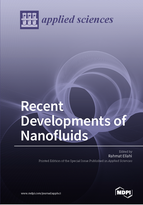Recent Developments of Nanofluids
A special issue of Applied Sciences (ISSN 2076-3417). This special issue belongs to the section "Chemical and Molecular Sciences".
Deadline for manuscript submissions: closed (15 March 2017) | Viewed by 50517
Special Issue Editor
2. Chair Professor, Center for Modeling & Computer Simulation, Research Institute, King Fahd University of Petroleum & Minerals, Dhahran, Saudi Arabia
3. Ex and founder Chairman, Department of Mathematics & Statistics, IIUI, Islamabad, Pakistan
Interests: fluid mechanics; nanofluid; heat transfer; porous media; boundary value problems, peristaltic motion and Blood flow
Special Issues, Collections and Topics in MDPI journals
Special Issue Information
Dear Colleagues,
Recent advances in nanotechnology have allowed the development of a new category of fluids termed nanofluids. A nanofluid refers to the suspension of nanosize particles, which are suspended in the base fluid with low thermal conductivity. The base fluid, or dispersing medium, can be aqueous or non-aqueous in nature. Typical nanoparticles are metals, oxides, carbides, nitrides, or carbon nanotubes. These shapes may be spheres, disks, rods, etc. By using these additives, one can increase heat transfer coefficient and consequently enhance the heat transfer value and performance of base fluids. Some of these fluids can be considered as Newtonian fluid, but in many applications the Newtonian model is not very accurate; therefore, it has generally been acknowledged that non-Newtonian fluids exhibiting a nonlinear relationship between the stresses and the rate of strain are more appropriate in technological applications as compared to Newtonian fluids. Many industrial fluids are non-Newtonian in their flow characteristics and refer to as rheological fluids, such as slurries (china clay and coal in water, sewage sludge, etc.), multiphase mixtures (oil-water emulsions, gas-liquid dispersions, such as froths and foams, butter). Further examples displaying a variety of non-Newtonian characteristics include pharmaceutical formulations, cosmetics and toiletries, paints, synthetics lubricants, biological fluids (blood, synovial fluid, salvia), and food stuffs (jams, jellies, soups, marmalades), etc. Moreover, simulation of boundary layer flow of nanofluid is another issue of this Special Issue that has various applications in engineering and industrial disciplines. Nanofluid technology can help to develop better oils and lubricants for practical applications. Nanofluids also strengthen solar energy application like heat exchangers design, some medical applications, including cancer therapy and safer surgery by heat treatment.
Existing literature bears witness that the investigations on said topic are still scant. In order to fill this gap, researchers are invited to contribute original research and review articles in the following potential topics (see keywords below).
Dr. Rahmat Ellahi
Guest Editor
Manuscript Submission Information
Manuscripts should be submitted online at www.mdpi.com by registering and logging in to this website. Once you are registered, click here to go to the submission form. Manuscripts can be submitted until the deadline. All submissions that pass pre-check are peer-reviewed. Accepted papers will be published continuously in the journal (as soon as accepted) and will be listed together on the special issue website. Research articles, review articles as well as short communications are invited. For planned papers, a title and short abstract (about 100 words) can be sent to the Editorial Office for announcement on this website.
Submitted manuscripts should not have been published previously, nor be under consideration for publication elsewhere (except conference proceedings papers). All manuscripts are thoroughly refereed through a single-blind peer-review process. A guide for authors and other relevant information for submission of manuscripts is available on the Instructions for Authors page. Applied Sciences is an international peer-reviewed open access semimonthly journal published by MDPI.
Please visit the Instructions for Authors page before submitting a manuscript. The Article Processing Charge (APC) for publication in this open access journal is 2400 CHF (Swiss Francs). Submitted papers should be well formatted and use good English. Authors may use MDPI's English editing service prior to publication or during author revisions.
Keywords
- Analytical modeling of nanofluid
- Numerical modeling of nanofluid
- Numerical or Analytical solutions of laminar/turbulent boundary layer nanofluid flows
- Convective heat and mass transfer in nanofluids for Newtonian and non-Newtonian
- Particle shape effects of nanofluid
- Heat and mass transfer in Newtonian and Non-Newtonian nanofluids flow
- Steady and Unsteady nanofluid flow problems
- Experimental data on nanofluid flows (internal and external)
- Application of nanofluid flows in medical processes
- Multiphase flow simulations
- Fractional problems






